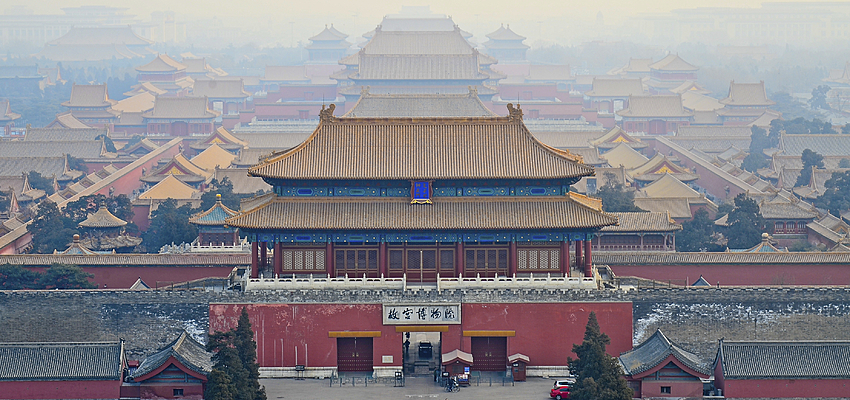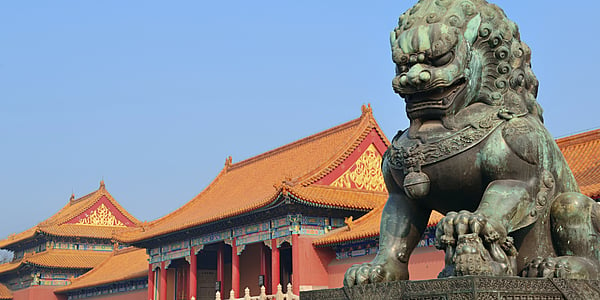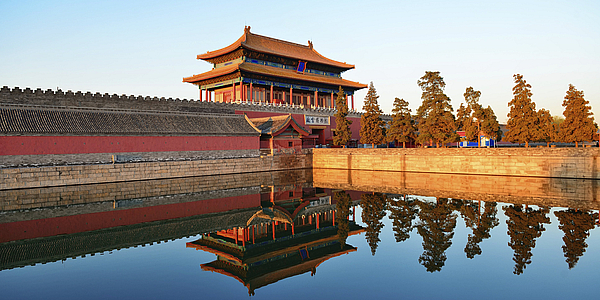


An iconic fixture of Chinese Culture, the Forbidden City is located on the edge of Tiananmen Square in Beijing. Upon coming face-to-face with this majestic monument, you get the impression of having traveled back through time to the Imperial age (well, as long as you can overlook the giant portrait of Mao pinned to its front). With a little imagination, you could even encounter the Emperor Yongle, the third emperor of the Ming Dynasty, who ordered it to be built in 1406.
It then took over ten years for the project to see the light of day. Covering an area of 72 hectares, the "Palace Museum" (as it is also known) remains perfectly preserved. A true gem in the open air that I command you to visit if you are traveling through Bejing !
An immense portrait of Mao welcomes visitors as soon as they enter the monument. Mao seems to be watching over the place, calmly and benevolently, while his tomb sits serenely just a few steps away (look around, find the endless line of Chinese tourists, and you'll find the tomb!)
Only after walking around the Forbidden City a little do the the imperial treasures of the Chinese civilization appear in the open, and the vastness of the Imperial City contains tightly guarded jewels and furniture. Your gaze is torn between Buddhas on one side, textiles on the other. Bronzes, musical instruments, lacquers, ceramics and ancient paintings The treasures continue to multiply as far as the eye can see. Everything seems to have been left in the same state as it was when the mandarins were in charge. When they worked for the Emperor, formulating political strategies for their time.
In this unique environment, the silence comes as a surprise. Everyone goes quiet to admire the surroundings. We are however not far from the adjacent main roads. With its peaceful silence, the Hidden City incontestably erases the intense activity of Beijing. The city seems to have traveled several centuries back in time despite the pressing crowds.

In line with the ambitions that prevailed at the time, the Emperor harbored idealized notions of divine perfection. He wished to construct a palace that would get as close as possible to the Divine Number, 10,000, which was the sole province of the divinities. Finally, as the figure nine was seen as a lucky number in China, he set the incredible goal of building 9,999 rooms in the City. It was a completely insane challenge that required an infinite source of labor as well as a gigantic investment.
It will therefore not come as a surprise to you that many of the 200,000 laborers lost their lives in the process, and the construction involved the mobilization of the entire country, especially to provide the necessary raw materials.
To understand the structure of the Forbidden City a bit better I recommend that you locate each of the two major parts of the Palace, around which the rooms are distributed. There is the Outer Courtyard, aimed at public life and grand official ceremonies. Then there is the Inner Courtyard, aimed at the private sphere and divided from west to east by an artificial river known as Jinshui He.
Curious minds will ask a thousand and one questions, and the details of the architecture only encourage this questioning. The best approach is to explore on foot and take the time to observe; why not do so in the company of a local guide who will provide you with a multitude of information and show you details that you might otherwise have missed?
Burned down by the Manchu in 1664, the Palace was rebuilt exactly as it was before. Since then, the centuries have passed but the Imperial City has remained. In 1987, it was registered as a World Heritage Site by UNESCO.
